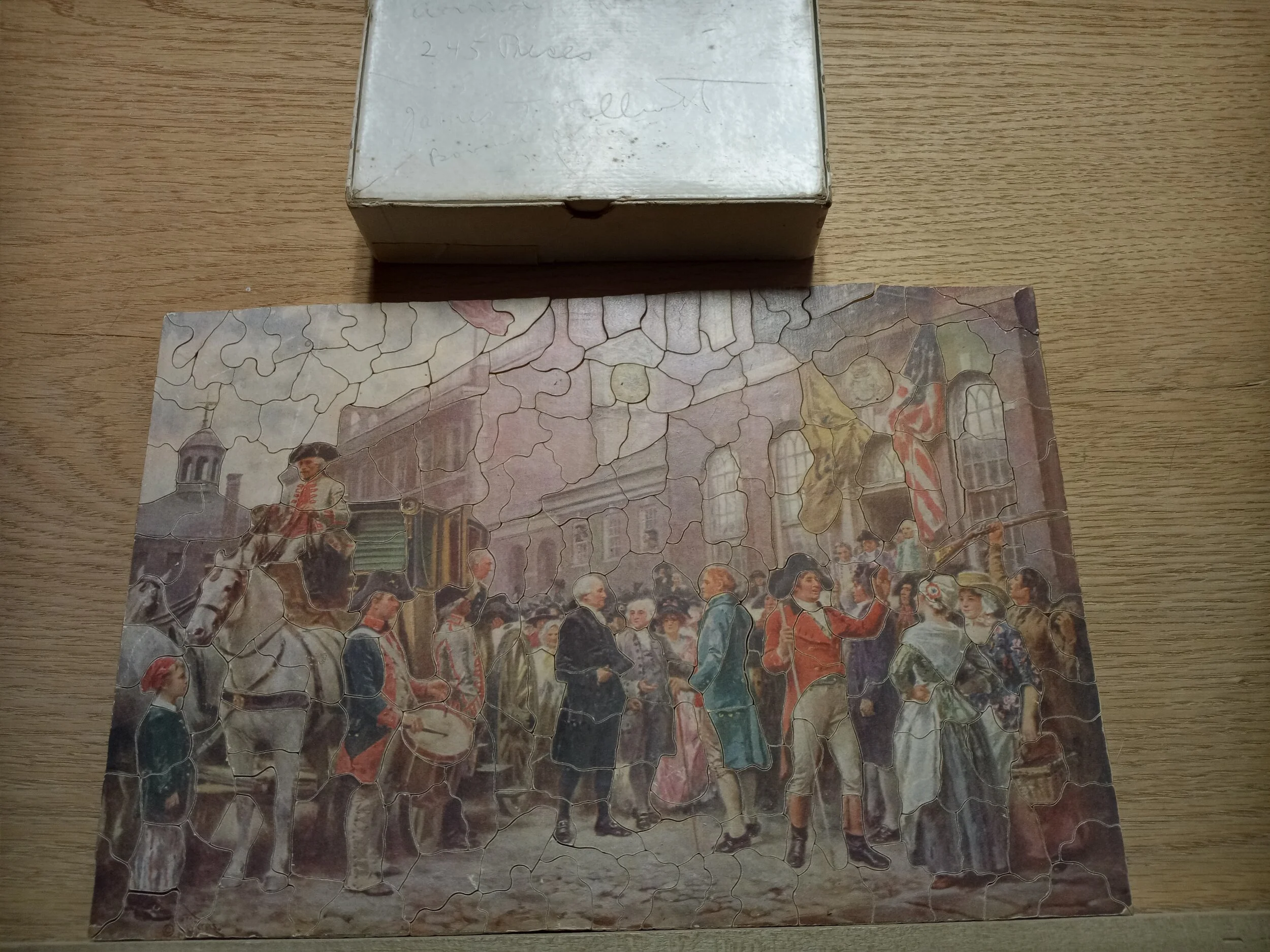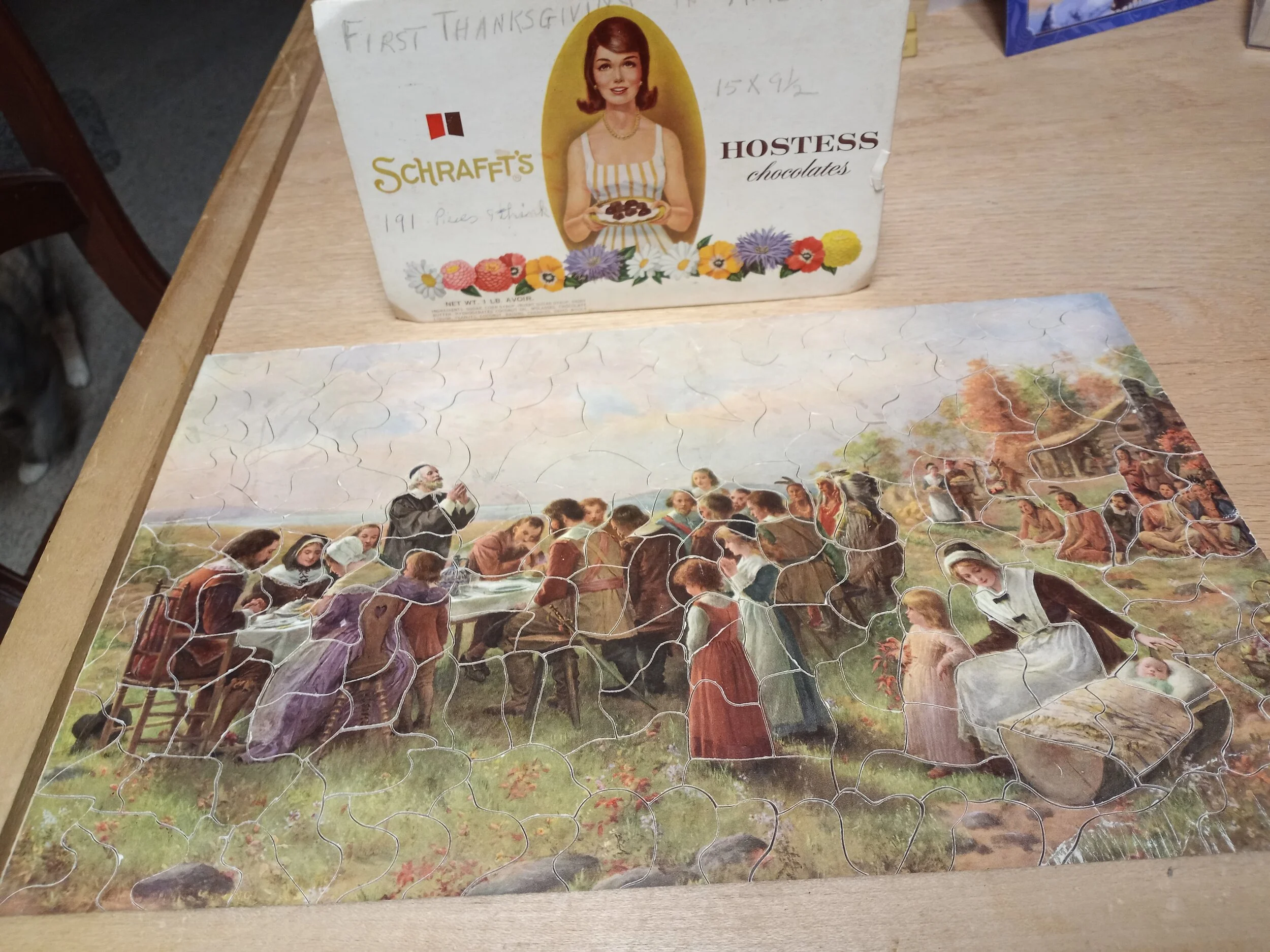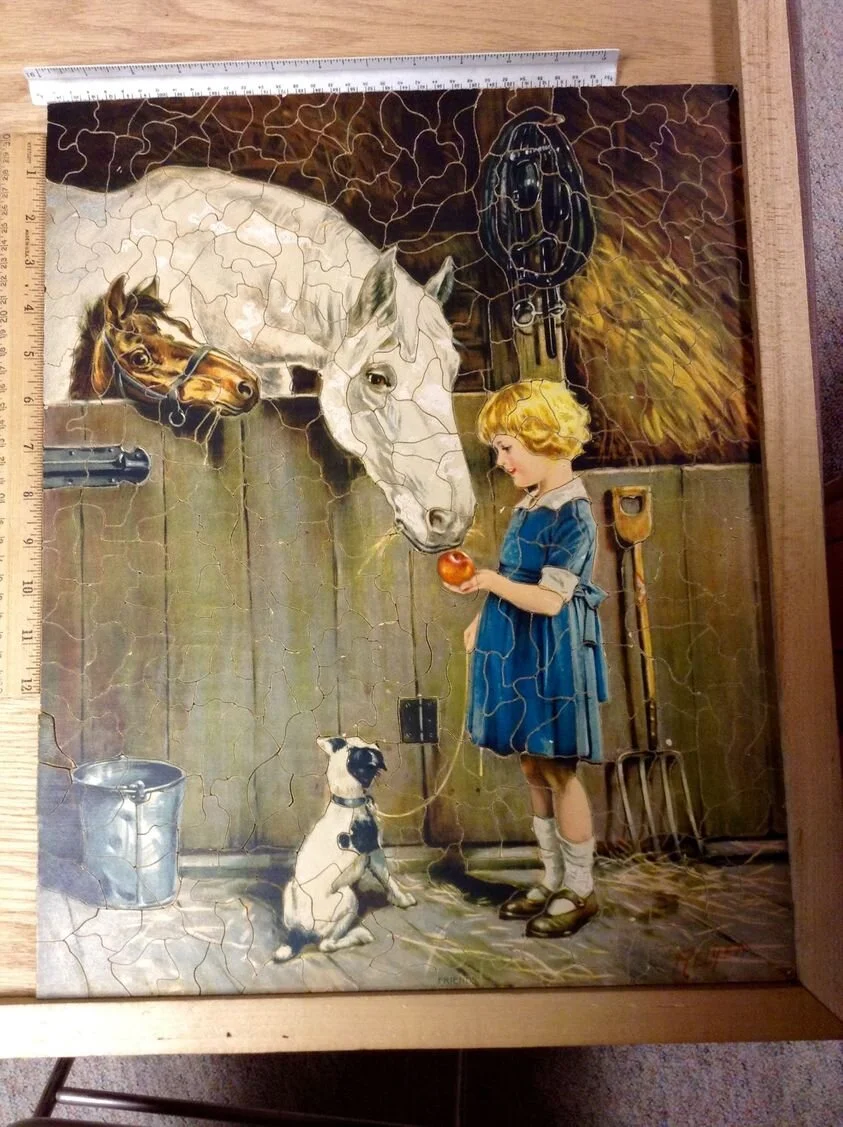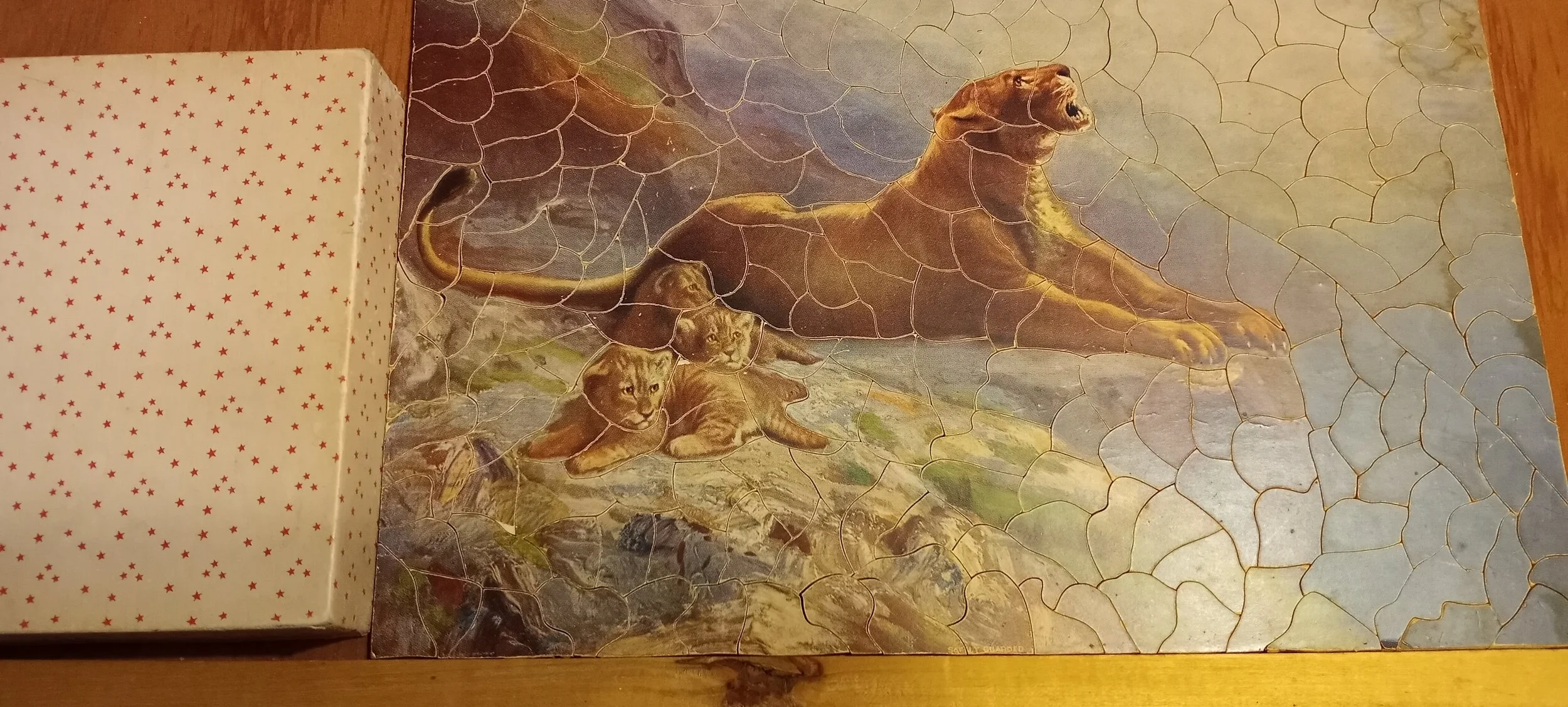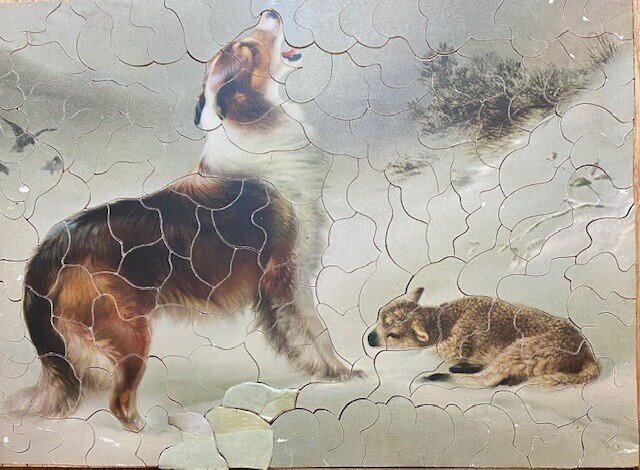
A history of wooden jigsaw puzzles in our family
BY: Jane Long Dilley
DATE: April 17, 2004
A bit of family history background: Two of my father's sisters, Marion and Marguerite, married in the 1920's; Marion married a local farmer in the mid-Catskill Mountains, James T. Elliott, who owned a fairly large dairy farm originally deeded to his ancestor, Thomas Elliott, from the original Hardenberg Patent--a gift from the Royal Crown for services rendered. Marguerite married Alexander P. Suter whose father worked for the Army Corps of Engineers, among other things being in charge of dredging the Mississippi River at St. Louis. Alec came to the Catskills to "the Brown House" near Roxbury, New York where the family summered.
Alec Suter was a professional carpenter; Jim Elliott, while a farmer, was talented at making things in wood: tables and other pieces of furniture, the occupier of time in the winter when not much outside farm work could be done.
As was common in our family in the '20's and '30's and later, family members frequently visited each other traveling back and forth over the mountains from New Kingston to Margaretville, where another sister lived, and to Roxbury. Alec Suter had lived and gone to school in Boston and had become a member of a "Puzzle Exchange" in Boston. When he moved to Roxbury, New York, the Puzzle Exchanges continued by mail.
The "Picture Puzzle Exchange" was located at 36 Bromfield Street, Boston, Room 5 1 , then Room 401, then yet another room, before it finally disbanded, selling its puzzles to the subscribers, probably in the late '20's.
Alec and Marguerite and Jim and Marion had gotten together occasionally, spending time doing puzzles together. When the Puzzle Exchange folded Alec said, "Jim, you could do this. Why don't you try your hand at making some puzzles."
Those were the days when the local barber shops, feed stores, grocery stores gave out yearly calendars to reward their regular customer, often with art work showing hunting, fishing or other outdoor scenes. From this art work Jim Elliott began his puzzle making. According to my cousin, Bill (Jim's son), this was about 1930, when Bill was an 8-year old.
Jim's equipment was an interesting bit of creativity: a small jigsaw with a pulley belt into the basement (through 2 holes he drilled in the kitchen floor) to reach a small water turbine. This water turbine was an outdated power generator from the basement of Bussey's Grocery (the place 13 miles away where one went once a week for supplies) in Margaretville. It had been used to grind coffee for the store but when rural electrification reached as far as this village center it was a piece of superfluous equipment which Jim bought to power his jigsaw. It was just the ticket, as right by the corner of his house near the outside basement door ran a lively ever-flowing spring. It was simple to run a pipe from the natural hole in the lawn giving access to the running water. He installed a pipe to carry the water away from the brook the few yards into the basement and then away to the nearby brook. By 1936 or so rural electrification (the "high tension" lines) reached even into the rural farm valleys though even before the 1930's individual farmsteads had gas generators to power electric lights and other equipment.)
In 1934 Jim and Marion's daughter, Bernice, needed $30 to go on her graduating class trip to Washington. Jim made puzzles for Bernice to take to school to sell at 1 1/2 cents per piece (or 1 cent; Bill wasn't sure). She made her $30. (I hope those 9 or 10 families know what a treasure they have.) Bill speculates that Jim probably made 50-60 puzzles. (Nancy Long Huntly and I have 60 between us so it was at least a few more than that. )
Marion must have been a very tolerant partner in this. It was very labor intensive besides sawing out each individual piece which he did with devilish skill to separate colors and shapes which left only subtle clues as to placement, saw blades were not so fine and each piece had to have the edges buffed to remove the burrs the sawing left. That was Marion's job which Jim made as easy as possible by rigging up a little table fan with sandpaper on the rubber blades. Each piece must be held against the fan blades just so--not too close—to achieve the light sanding—and rotated to reach each edge. More evidence of her tolerance and support of this activity would have been the layer of fine sawdust that would have reached even into the next room, to say nothing about the holes in the kitchen floor.
In those depression times entertainments were what you made yourself, which encouraged the visits to family members and neighbors for card playing, dinner, doing of puzzles together. And, of course, there weren't the entertainment options even for money.
Bill didn't start making puzzles until after Jim died in ____. He finds he breaks 3-5 blades per puzzle. Each blade cuts on the down stroke only and it's important to be sure the blade is properly installed. Bill's technique is to cut out a section of the picture and cut pieces from that. It's very easy to get into a pattern that makes too many pieces the same shape, making doing the puzzle too difficult, "But a puzzle should be hard or what's the point," he says. Jim didn't seem to get into a shape pattern, though he had some distinctive pieces especially along the edge (that don't look like edge pieces, or like corners). Bill still sands the edges of each piece with sandpaper wrapped around the center shaft of that little table fan. You have to be careful not to press too hard or you'll send the piece across the room. If you did that out in his shop you would never find the piece again: it’s a rabbit warren in there.
For more information on handmade jigsaw puzzles visit Bob Armstrong's Old Jigsaw Puzzles (oldpuzzles.com)
For information on how to make jigsaw puzzles visit Bob Armstrongs son’s site at Armstrong Puzzles - Handmade Wooden Jigsaw Puzzles (newpuzzles.com)
Puzzles in the Elliott Collection cut by James T. Elliott and J. William Elliott
Note: These puzzles are located at my house (Sally Elliott Scrimshaw’s in Delhi, NY). I’m just getting started putting together approximately 40 of the puzzles at my location.
Jane Long Dilley has about 70 puzzles in her collection and has been photographing them for 2 years. The photos are on a google drive and we will be posting the site address soon.
The Puzzles below are at my house (Sally Elliott Scrimshaw) and I’m just getting started photographing them.
George Washington Arrives in Philadelphia - 245 pieces - 8 1/2 x 13"
First Thanksgiving In America - 191 pieces - 15 x 9 1/2
Two Men Going Over Rapids - ? pieces - 9 x 13 1/2"
Safely Guarded - 253 pieces - 11 3/4" x 15 3/4" -
